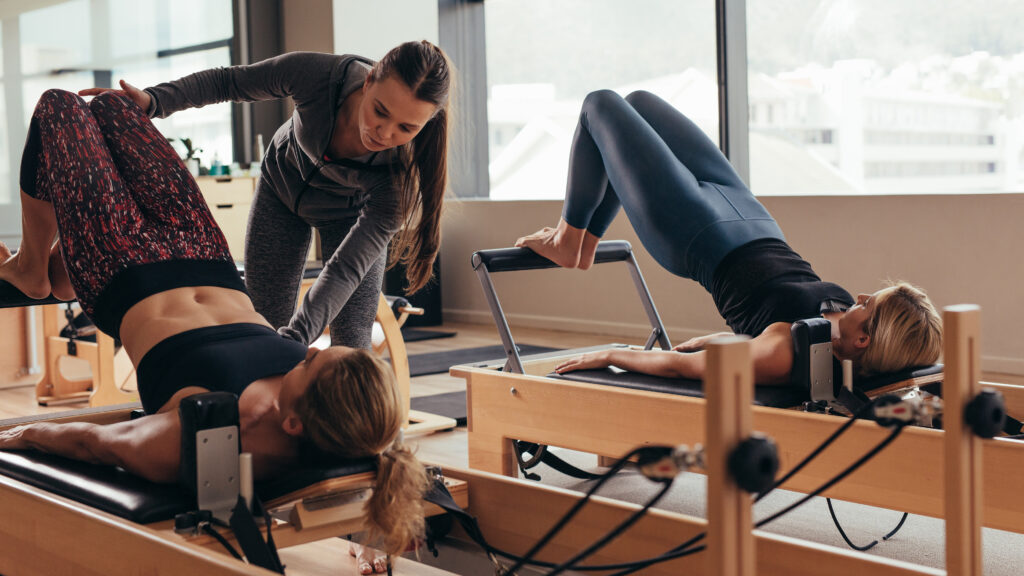How is Pilates with Physical Therapy different than traditional physical therapy?
Pilates is a movement-based methodology that focuses on the quality of the movement and how a pattern of motion is organized. As such, it can help to enhance traditional physical therapy by optimizing posture and alignment with exercises and rehab activities to find the most successful activation of muscles. The expertise and skills of a licensed physical therapist can also enhance Pilates-based exercise, by directing safe, guided exercises that protect injured or healing tissues and challenge progress effectively. Basically, Physical Therapy & Pilates work very well together to help you achieve your best outcomes!
Physical therapy education nationwide is now at the doctorate level, so depending upon when a therapist graduated, they may have a doctorate. They are able to use the “Dr.” designation and are a Doctor of Physical Therapy (DPT). (There are many types of doctoral degrees, including Medical Doctor (MD) and Doctor of Osteopathy (DO), which you may be familiar with for your primary care physician.)

Are physical therapists doctors?
A physical therapist with the entry-level degree, whether it was a master’s of physical therapy (MPT) from several years ago or a doctor of physical therapy (DPT) in recent years, will be a full-fledged Physical Therapist, with the PT designation after their name. Each therapist will continue to get ongoing education each year to maintain their state professional license and keep up with the latest information and changes in the field.
Some therapists, such as Dr. Heidi Fisher, elect to get an advanced degree. These degrees are similar to a PhD level, but may be more clinical in nature. Others might be in business or health policy. The degree Dr. Heidi Fisher obtained from Andrew’s University, as one example, is a Doctor of Science in Manual Physical Therapy (DScPT).
Is physical therapy right for me?
If you have had a prolonged illness or an injury or a surgery, physical therapy may be right for you. It can help get you back on track safely with targeted exercise strategies and hands-on treatments to get you back to your favorite activities and hobbies. A physical therapist can help identify weakness in muscles or activities or blocked movement patterns in joints and help to address them, so that they don’t provide more issues or injuries down the road.
Maybe you haven’t had a specific surgery or injury, but physical therapy may still be right for you. You may be getting aches and pains that stick around for longer periods of time or noticing some stiffness or limitations in movements. Are those issues starting to impact your enjoyment of your favorite activities and hobbies? Maybe you have noticed changes in your balance or endurance. Perhaps you keep working at getting stronger with a certain exercise, but feel like you just can’t make a change. Physical therapy can help! Dr. Heidi Fisher can help assess what is happening and work with you to make a plan and a customized program to help you keep moving and enjoying life. Plus, it is great to start working on the issues before they get worse or lead to an injury. Schedule a visit with A Wise Move Physical Therapy & Pilates today!
How is Pilates on the equipment (e.g. Reformer, Combo Chair) different than mat exercises or classes?
Pilates equipment can make the Pilates experience different in several ways. First of all, the equipment itself provides something fun and unique to allow for a different experience of movement, strengthening, flexibility and balance work. Think of it like participating in an activity like jogging, hiking or swimming that doesn’t involve any extra equipment; that would be like mat exercises. Now picture activities like rollerskating, skiing, baseball or tennis. They are still all fun physical activities. The equipment just provides more options on what you can do and how you can create and respond to the movement. If you haven’t tried exercise on Pilates equipment before, schedule a session today to experience new and fun movement experiences!
The Pilates equipment can also change the movement experience, when it is needed. If someone has trouble getting up and down from the floor, the Pilates Reformer and Chair allow you to exercise on a supported surface up off the floor. The springs that create the resistance on some of the equipment, can also provide support for the movement. Maybe a mat exercise is really challenging to avoid your neck or shoulders getting tight and sore. The same or a similar exercise on the Reformer with the feet or arms in the straps can help provide enough support for the neck and shoulders to allow you to get stronger with the core muscles without the unnecessary pain/strain. Other equipment like the Oov and Pilates arc help to learn how to move and control certain areas, while stretching and supporting other areas.
Each piece of equipment has many different exercises that you can do on it, and each provides support or feedback to our bodies in different ways to enhance our movement experience and optimize the strength and flexibility gains we get. Dr. Heidi Fisher will work with you to find the best exercises and the optimal combination of equipment to explore and discover successful ways of moving, keeping healthy and fit. The variety of options the equipment provides also helps to make sure you never get bored with your exercise routine.